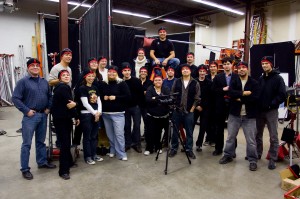
Film Training Manitoba has created a unique opportunity for our Aboriginal trainees this past year with a series of Film Shoot Workshops. The goal of these workshops was to create a realistic working environment so that trainees would not only learn about their areas of interest, but would also get a real sense for how a film shoot unfolds.
“The idea of this workshop series was to show our trainees that being a successful crewmember is not just about the final product, it’s about the process you take to get to that product,” explained Neila Benson Executive Director of FTM. Benson also stressed that these workshops were about creating mentorship opportunities for the Aboriginal crew trainees. A working film set is an extremely hectic environment and to have trainees be able to stop the work and ask questions they may have about the process would be very difficult on a working film set.
The first workshop took place in March and was made possible with the cooperation of CAHRD (Centre for Aboriginal Human Resource Development). Directed by Randy Guest and shot on location at the CAHRD offices, this documentary on the CAHRD organization was created over the course of three days. The trainees were matched with experienced crewmembers for the duration of the shoot and were guided through the process of making a documentary film.
During the shoot, First Assistant Director Richard Duffy took FTM trainee Alanais Moar under his wing. Moar was given a first-hand idea of all the paperwork involved in a film shoot, including the creation of the famous Call Sheets. The project went into post-production and a short, twelve-minute film was created. A screening is planned for the trainees and copies of their work will be kept at the FTM office for future reference.
This past August, FTM made it possible for our trainees to build on what they learned in March with the second workshop in this series that showed them first-hand how a dramatic production is created. With a script written by local actor Ryan Black, and John Barnard of Farpoint Films as the director, the trainees began the day with a group discussion facilitated by FTM staff member Adam Smoluk, who recently directed his second feature film Foodland.
According to Smoluk, “It was cool because we had each crewmember review their dept and introduce themselves to the group. It was very revealing, I think, for these trainees to hear what each department is responsible for and to understand the big picture of how a film shoot comes together. That type of knowledge and training just makes everyone a better crew member.”
Knowing that the goal of this workshop was to create a strong training environment for the trainees, Barnard was able to create a realistic adaptation of a film shoot as well as a strong training environment for everyone involved. “Of course I said yes. FTM is an invaluable organization for the entire film community,” said Barnard. “I began by breaking down the script for blocking and beats. I knew that the trainees would need more time on each scene and I took that into consideration. I think we ended up with a great project that allowed them to learn at their own pace.”
Director of Photography Stephan Recksiedler and Gaffer Ben Stoffer mentored FTM trainee Imre Horvath in the lighting department, teaching him the basics of properly lighting a set. This mentorship was very successful and Horvath spent another three days at PS Prairies under Recksiedler’s tutelage. As a result of his hands-on training, Horvath was placed on the set of “Cashing In” as an electrics intern and is currently working under Laurence Mardon.
This series of workshops came to an end with the third Film Shoot Workshop, which took place at PS Prairies on October 21st and 22nd. On day one, the trainees were divided into two groups and given a tour of the facilities. This gave them the opportunity to see the technical side of filmmaking, and to learn more about the equipment that is used on a set.
After the facility tours were over, the two groups came together again to review what would take place during the Poor Man’s Process[1] shoot, scheduled for day two. Once again, FTM invited John Barnard to direct the trainees. Barnard reviewed the process of this type of shoot, including its purpose. A script was handed out to the trainees and Barnard broke down the shot angles and lighting styles for everyone.
The trainees were also given a presentation from Laurence Mardon. Mardon demonstrated the different lighting techniques he has learned over the past 20 years as a Gaffer, including a few personal tricks that have proven very effective on set. He also reviewed the different techniques and equipment that the trainees would be using for the shoot the next day.
The Poor Man’s Process[1] took place on the second day of the workshop. The trainees were given their roles and responsibilities, but once filming began the trainees were rotated into different roles. This gave them the opportunity to experience the different jobs and departments. From time to time, the trainees were brought to the monitor and shown how different techniques affected the final product. Throughout the entire shoot several senior crewmembers were on hand to guide the trainees and assist them throughout the shoot.
Trainee Joanne Soldier was placed in the Grip position, which meant learning the backdrop, light diffusions, equipment, and ensuring that everything was properly secured. “I found this workshop not only informative but also fun, “ said Soldier. “Everyone at Film Training Manitoba, PS Prairies, and the participating members of the film community did an awesome job with this workshop. I am looking forward to future opportunities like this. Meegwetch.”
Trevor Klippenstein, Rental Coordinator at PS, was very impressed by the group. “Recognizing and appreciating the quality of instruction and resources on hand, [the trainees] enthusiasm flourished and it didn’t take long for the group to engage us with questions. Everyone involved provided top-notch insight into practical and theoretical application that the students could digest with ease. My feeling was that the students came away with more then they bargained for and I believe FTM is definitely on the right track in terms of structuring a training program like this, regardless of anyone’s background and expertise.”
For more information on Film Training Manitoba and its programs, please visit our website at www.filmtraining.mb.ca.
Written by Dawn Bourbonnais
[1] Poor Man’s Process (PMP): A way of creating the illusion of movement for an interior scene in a car by shaking it up and down and flashing lights and shadows across it.
